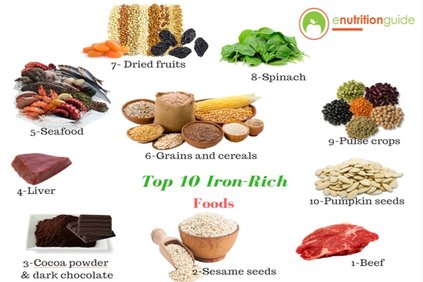 Iron deficiency is the most common nutrient deficiency in the world (1). Many women are iron deficient, especially those who are menstruating, pregnant, post-partum or breastfeeding. Iron deficiency is also commonly seen in those with chronic blood loss and/or gastrointestinal absorption issues. Untreated iron deficiency can lead to iron deficiency anemia, which occurs when the body lacks sufficient amounts of iron to form normal red blood cells. Without enough iron, the body can’t produce enough hemoglobin for red blood cells to deliver oxygen from the lungs to the tissues. These are some of the symptoms that one may experience with iron deficiency or anemia (2):
 Iron is Vital for Many Processes in the Body In addition to delivering oxygen to the tissues, iron has many other important roles in the body. It is one of the most important nutrients for immune function as it maintains white blood cell levels, antibody production and thus fights off infections. This might contribute to getting recurring colds/flus. Iron is also required for the production of amino acids, hormones and neurotransmitters, which might explain lower concentration levels or lower thyroid function, as iron is an integral part of the enzyme reaction that produces neurotransmitters and thyroid hormones (3). Causes and Diagnosis of Iron Deficiency Iron deficiency is most commonly caused by (2):
Iron Studies Diagnostics for iron deficiency anemia consist of a low hemoglobin, low serum iron, low serum ferritin (the storage form of iron), a low transferrin saturation and a high total iron-binding capacity. It is important to note that a ferritin level may be misleading, especially if there is acute or chronic inflammation as ferritin is an acute phase reactant and increases in the presence of an inflammatory process (1). Treating Iron Deficiency Treatment of iron deficiency should be targeted towards the cause of the deficiency. For example, a study by Rockey et al. (1993) demonstrated that 60% of adult patients with iron deficiency anemia may have an underlying gastrointestinal disorder (e.g. low stomach acid or excess inflammation), which needs to be investigated and treated and similarly women with heavy menstrual bleeding (4). Once the cause has been established and treatment is underway, iron-deficiency anemia is usually reversible with iron repletion, which usually includes the use of iron supplements and food sources of iron (see image above). Iron status should be assessed before starting iron supplementation as iron overload may increase the incidence of cardiovascular disease and other chronic illnesses as well as cause harm to people who carry the iron-overload gene (1). Food Sources There are two types of dietary iron; heme iron (animal based) and non-heme (plant-based) iron. The heme form has been demonstrated to have a high bioavailability than the non-heme form (1). In addition, the acidic environment of the stomach and certain foods are known to increase the bioavailability of dietary iron (2). The guideline for recommended iron intake is 18g for women aged 19 – 50 (6). Iron Supplements Iron is available in many dietary supplements and there is quite a bit of variation among them with respect to dose, absorption, and effects on the gastrointestinal system. There are forms of iron in supplements for example that contain better bioavailability than others, for example ferrous iron is more bioavailable than ferric iron and other forms such as heme iron or polysaccharide-iron complexes may have fewer gastrointestinal side effects (i.e. constipation, nausea). Important Tips for taking Iron
References
0 Comments
Leave a Reply. |
AuthorDr. Lara is a Naturopathic Doctor who is passionate about helping and empowering her patients in their journey towards lifelong health and wellness Categories
All
Archives
September 2021
|

